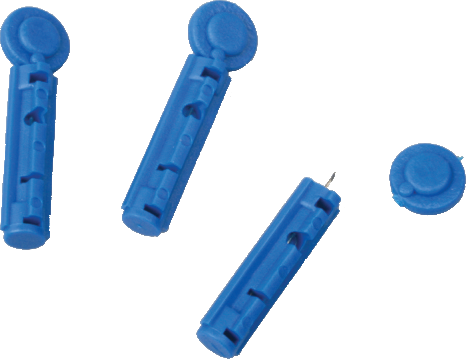
Ref. No.: NME000202
A blood lancet is a small, sharp device that is used to puncture the skin and collect a small sample of blood. Blood lancets are usually made of plastic or metal. They typically have a pointed tip and a knob or handle that is used to twist the lancet into the skin.
Blood lancets are used for various purposes, such as testing blood sugar levels or checking for anemia.
Plastic Blood Lancet, Twist Top, Light Blue Color. Item. No.: NME000202
A blood lancet is a small, sharp device that is used to puncture the skin and collect a small sample of blood. Blood lancets are usually made of plastic or metal. They typically have a pointed tip and a knob or handle that is used to twist the lancet into the skin. Blood lancets are used for various purposes, such as testing blood sugar levels or checking for anemia.
2. How is a Blood Lancet Used? Blood lancets are typically used by pressing the pointed tip against the skin and then twisting the knob or handle. This action punctures the skin and creates a small opening through which a drop of blood can be collected. Blood lancets are usually used on the finger, but they can also be used on other areas of the body, such as the earlobe.
3. What are the Benefits of Using a Blood Lancet? There are several benefits of using a blood lancet. Blood lancets allow for a quick and easy way to collect a small sample of blood. They are also relatively painless and cause minimal discomfort. Additionally, blood lancets are typically very affordable and easy to find.
Blood lancets are small, sharp devices that are used to puncture the skin and obtain a small blood sample. They are often used by diabetics to test their blood sugar levels. Blood lancets should be used with caution. The devices are very sharp and can cause serious injury if not used properly. Always hold the lancet firmly in your hand and point the tip away from your body.
Gently press the lancet against your skin and twist the handle to puncture the skin. Once the skin is punctured, quickly remove the lancet and apply pressure to the area to stop any bleeding. If you are not sure how to use a blood lancet properly, ask your doctor or pharmacist for advice.
The NME Plastic Blood Lancet is a twist top lancet that is made of plastic. It is light in weight and has a small needle that is used to puncture the skin. The NME Plastic Blood Lancet is easy to use and is safe for both children and adults.
It is also disposable and can be disposed of after use. The NME Plastic Blood Lancet is available in different colors, including blue, green, pink, and purple. It also comes in different sizes, so you can choose the size that best suits your needs. The NME Plastic Blood Lancet is affordable and can be found at most pharmacies or online retailers.
1. The NME PLASTIC BLOOD LANCET (TWIST TOP) is a plastic blood-letting device that is used for light bleeding.
2. It is important to read all instructions carefully before using this product.
3. Do not use this device if you are allergic to plastic.
4. This device is for single use only.
5. Do not reuse or share this device with others.
6. Discard the device after use in a sharps container or other appropriate waste container